Introduction
In the realm of diabetes management, understanding the nuances of glycemic control is paramount. Fructosamine and HbA1c are two critical biomarkers that provide insights into blood glucose levels, each serving distinct yet complementary roles.
- While HbA1c offers a long-term view of glucose regulation over the past two to three months,
- fructosamine reflects shorter-term fluctuations, making it particularly valuable in scenarios where rapid adjustments in treatment are necessary.
Recent studies have highlighted the significance of these markers, emphasizing their utility not only in clinical assessments but also in tailoring individualized treatment plans.
This article delves into the fundamental concepts surrounding fructosamine and HbA1c, outlines a systematic approach for converting between the two, and discusses their clinical importance through real-world applications, ultimately aiming to enhance diabetes care and patient outcomes.
Understanding Fructosamine and HbA1c: Key Concepts
Fructosamine to A1C is a biochemical compound that forms when glucose binds to proteins, serving as an indicator of average blood glucose levels over the preceding 2-3 weeks. In contrast, the glycated hemoglobin test measures the percentage of hemoglobin that has undergone glycation due to prolonged exposure to glucose, reflecting average blood glucose levels over the past 2-3 months. Understanding the differentiation between these two markers is crucial for effective management of the condition, as they provide complementary insights into both short-term and long-term glucose control.
Recent studies indicate that combining Model 2 with glycosylated albumin (GA) achieves an area under the curve (AUC) of 0.7834, underscoring the relevance of these markers in assessing glycemic control. Significantly, the odds ratio for a history of diabetes with blood sugar levels exceeding 8.9% is 39.61, emphasizing the considerable risk linked to elevated blood sugar levels. Furthermore, Ishwarlal Jialal states, 'Disclosure: Ishwarlal Jialal declares no relevant financial relationships with ineligible companies,' adding credibility to the discussion.
Additionally, a case study titled 'Evaluation of Glycemic Control in Beta Thalassemia Major' illustrates the practical application of these markers, noting that while HbA1c remains a good marker for worsening glucose homeostasis, the comparison of fructosamine to A1C has emerged as a valuable alternative for assessing short-term glycemic control. Consequently, these measurements not only facilitate monitoring but also inform treatment strategies, ultimately aiding in improved outcomes for individuals. At T 2 Solutions, we are committed to empowering diabetes management through comprehensive education and community support.
As a new resource hub for Type 2 and Type 3 Diabetes, we encourage those recently diagnosed to subscribe for updates and engage with our resources, ensuring you have the tools necessary for effective care.
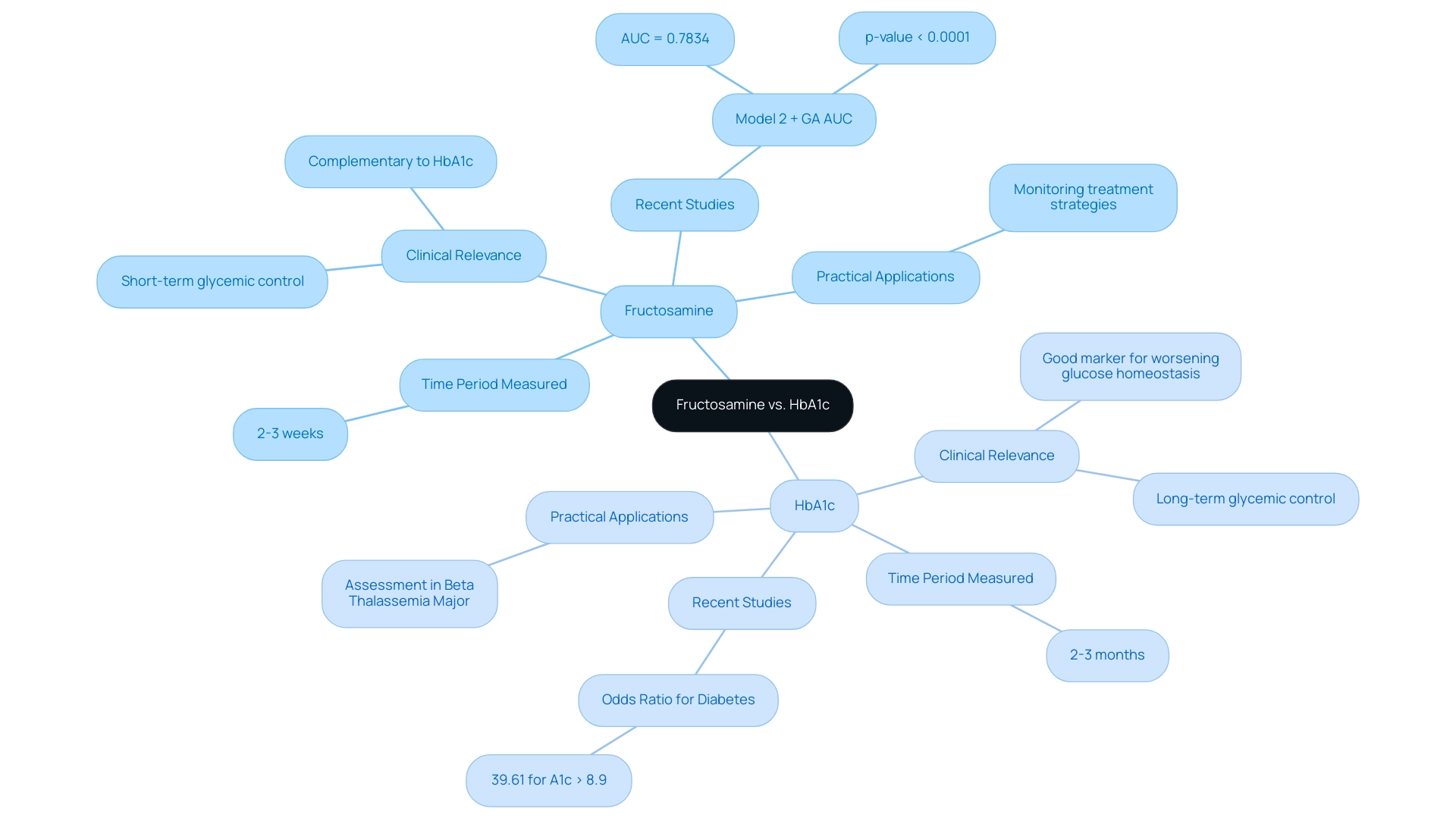
Step-by-Step Method for Converting Fructosamine to HbA1c
To transform a specific compound into glycated hemoglobin, follow these detailed steps:
-
Obtain Glycation Level: Begin by measuring the patient's glycation level in micromoles per liter (µmol/L).
Use the Conversion Formula: The formula for converting fructosamine to HbA1c is as follows:
[ \text{HbA1c} (\%) = \left( \frac{\text{Fructosamine} (\mu mol/L) - 150}{5.4} \right) + 6.1 ]
This formula effectively accounts for the average lifespan of glycated albumin in the bloodstream, providing a reliable estimation of HbA1c levels. Additionally, fructosamine to A1C can be calculated using the formula:
[ \text{Fructosamine} (mmol/L) = (\text{HbA1c} - 1.61) \times 58.82 ]. -
Calculate glycated hemoglobin: Insert the assessed sugar value into the formula to derive the estimated glycated hemoglobin percentage.
-
Interpret Results: Carefully analyze the resulting blood sugar level in the context of the individual's comprehensive diabetes management plan. This method is especially advantageous, as the joint assessment of serum levels and plasma glycosylated hemoglobin can improve management strategies, particularly when clinical data and glycosylated hemoglobin levels are inconsistent. As Leanne expressed, 'Thank you for any information you can give me to help better understand this,' highlighting the need for clear communication in patient education. Recent case studies, including the one named 'Use of Fructosamine in Childhood Diabetes Management,' have shown its usefulness in evaluating short-term glucose regulation, especially in difficult clinical situations such as anemia or kidney disease, where alternative metrics may not be as revealing. By following these steps, healthcare providers can ensure more accurate monitoring and effective treatment modifications.
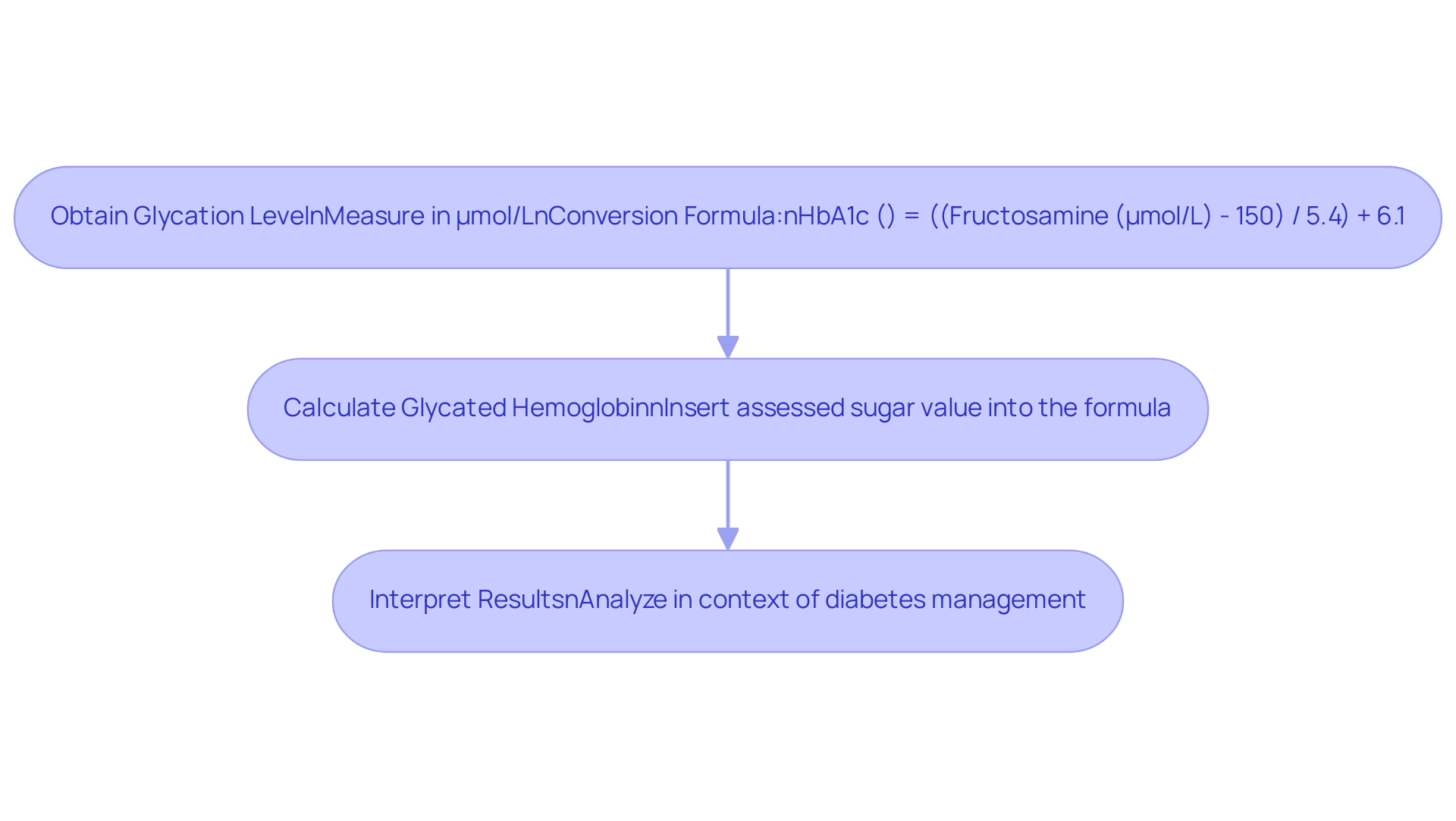
Clinical Importance of Fructosamine to HbA1c Conversion
The transformation of fructose derivative to HbA1c, which can be assessed through fructosamine to A1C, holds substantial clinical significance, enabling healthcare providers to evaluate glycemic control across different temporal dimensions. Fructosamine to A1C serves as a valuable marker for assessing short-term fluctuations in glucose levels, especially in individuals with conditions that may interfere with hemoglobin, such as anemia or specific hemoglobinopathies. This flexibility is essential, as emphasized by a study showing that the model including sugar levels exhibited an area under the curve (AUC) of 0.7834 in forecasting new cases of the condition, illustrating its effectiveness.
As highlighted by V.A.F., who has obtained research funding from leading pharmaceutical firms, the incorporation of specific sugar markers in blood sugar management is vital for customizing patient-specific interventions. Additionally, a study by Hashimoto et al. has demonstrated that sugar protein levels can assist in estimating the occurrence of mellitus, further reinforcing its clinical significance.
By facilitating the conversion of these values, clinicians can more effectively tailor management strategies, ensuring that patients receive targeted interventions that align with their unique health profiles. Moreover, a case study focusing on glycemic indices at baseline revealed that:
- Group 1
- Average A1C of 8.7%
-
Fasting blood glucose of 9.91 mmol/L
-
Group 2
- Mean A1C of 6.6%
- Fasting blood glucose of 7.89 mmol/L
Such distinctions emphasize the essential function of glycation products, particularly the relationship from fructosamine to A1C, in blood sugar management, especially in developing personalized treatment strategies.
Furthermore, correlation estimates in 10,000 resamples exceeded 0.80 for all comparisons, indicating the robustness of fructosamine measurements across various demographics.
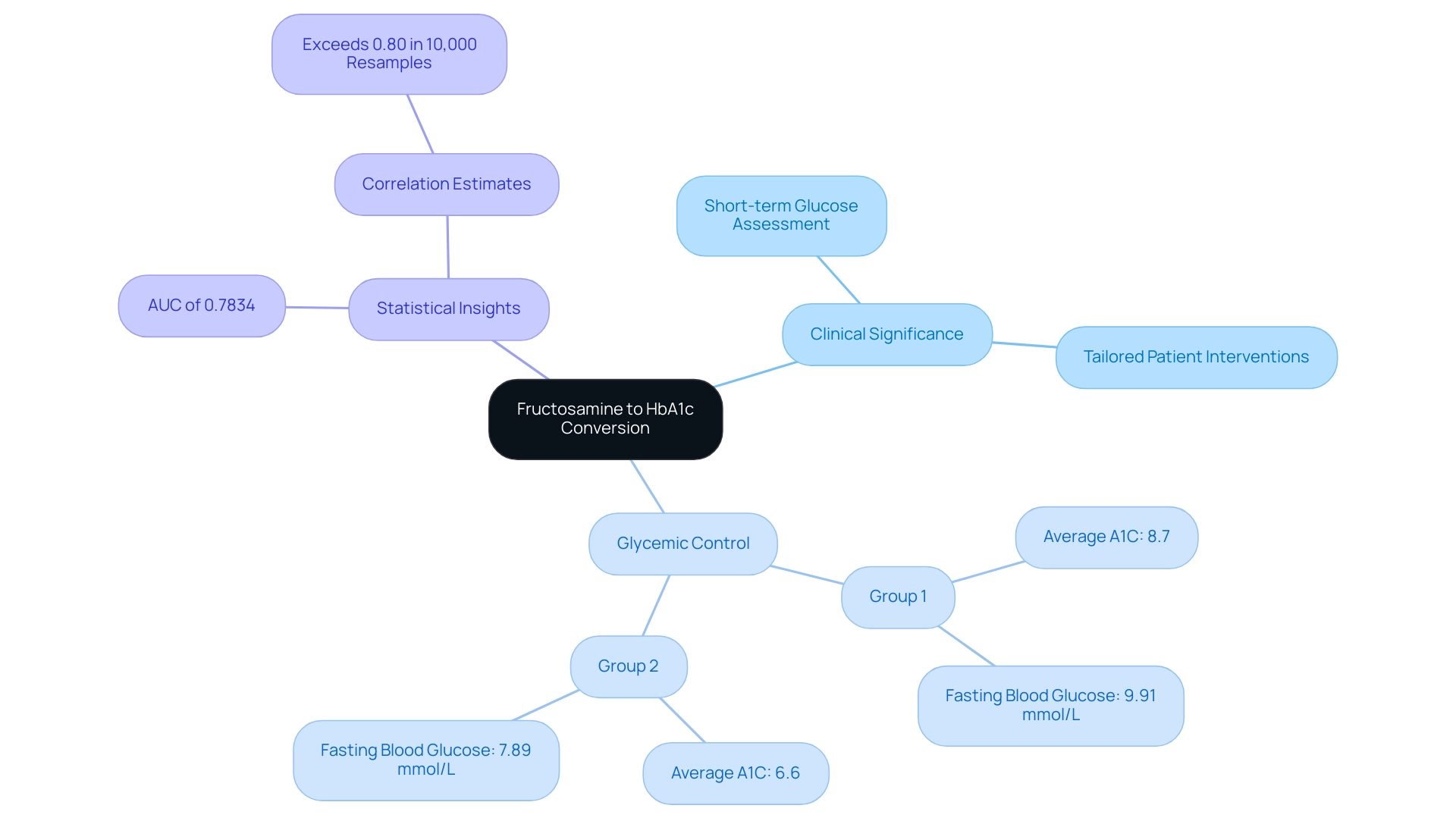
Comparative Analysis: Fructosamine vs. HbA1c
Fructosamine to A1C are both critical indicators of glycemic control, each with unique advantages and limitations essential for effective management of the condition. As T2DSolutions launches as a new resource hub for education on managing blood sugar, it provides valuable tools and calculators to assist those recently diagnosed in understanding these indicators.
- Fructosamine: This biomarker reflects glucose control over the preceding 2-3 weeks, making it particularly useful for individuals needing rapid adjustments in their therapy. Its timely insights can significantly enhance patient management; however, it is important to note that sugar protein levels may be influenced by conditions that affect protein levels, potentially skewing results. Ayo P. Doumatey has emphasized this aspect, stating,
Therefore, we established a reference interval for serum fructosamine and evaluated its utility as a potential glycemic biomarker that is not influenced by abnormal hemoglobin.
Furthermore, the areas under the curve (AUC) for serum fructosamine in identifying individuals with uncontrolled glycemia and type 2 metabolic disorder (T2D) were found to be 0.92, indicating its strong effectiveness as a glycemic marker.
- HbA1c: In contrast, HbA1c provides a longer-term view of glucose control, reflecting average levels over a span of 2-3 months. This measure is widely regarded as the standard for diabetes management, as it is less susceptible to acute fluctuations.
However, its efficacy may diminish in patients with certain hemoglobinopathies, leading to distorted results when comparing fructosamine to A1C; research underscores the importance of distinguishing between these two measures. For instance, a study found a strong correlation between glycated hemoglobin and three-month self-monitoring blood glucose (SMBG) patterns, with a correlation coefficient of r = 0.76 (95% CI [0.58; 0.87], p < 0.001). This suggests that while the glycated hemoglobin is a dependable metric, the glycation end product can act as a useful instrument in particular clinical situations, especially when swift evaluation is necessary.
Additionally, routine clinical care includes measuring HbA1c, urinary albumin, protein, and serum creatinine without batching, ensuring trustworthy data collection and analysis, which aids in the comprehension of management and its complications. Grasping these differences enables healthcare providers to choose the most suitable test for each individual, ultimately boosting adherence to treatment and enhancing overall management. It is essential for patients to periodically check their blood glucose status to ensure effective management of their condition.
As T2DSolutions launches, we encourage you to subscribe for updates and access comprehensive resources and support to navigate your condition, including tools and calculators for conversion between two specific blood markers.
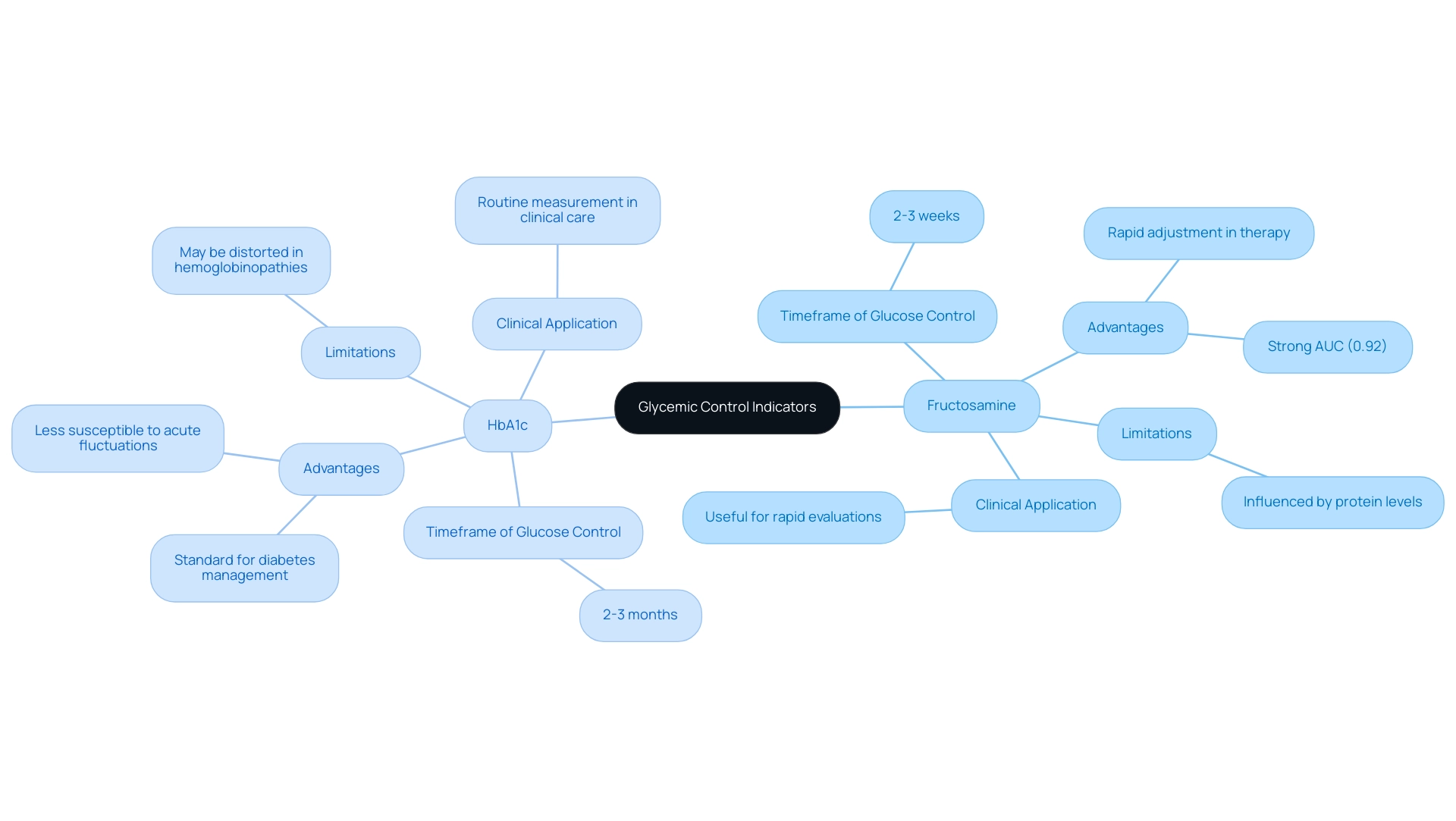
Real-World Applications: Case Studies in Fructosamine to HbA1c Conversion
Examining case studies can illuminate the practical application of converting fructosamine to HbA1c in diabetes management:
-
Case Study 1: A 45-year-old individual with type 2 diabetes exhibits fluctuating blood glucose levels. Upon measuring a fructosamine level of 300 µmol/L, conversion to glycosylated hemoglobin reveals an approximate value of 9.0%. This assessment enables the healthcare team to promptly modify the individual's medication regimen, ensuring better glycemic control.
-
Case Study 2: An individual with chronic kidney disease presents with a blood sugar level of 6.5% but suffers from recurrent hypoglycemic episodes. A later measurement of 280 µmol/L suggests that the individual's glucose regulation may not be as consistent as indicated by the blood test result. This discrepancy prompts the healthcare provider to reevaluate the treatment approach, demonstrating the necessity of analyzing both fructosamine to A1C for optimal management of the condition.
These case studies highlight the essential importance of using both specific markers together, enabling informed treatment choices that address the changing requirements of individuals with health conditions related to blood sugar. Furthermore, it is important to note that glycemic goals (GG) can be altered by 0.1% for each 213 mg/24 h of urinary albumin, highlighting the intricate relationship between these markers and glycemic control. As Ishwarlal Jialal states, monitoring both fructosamine and HbA1c levels is essential for effective management of the condition.
Additionally, a study titled "Comparison of Glycated Albumin and Hemoglobin A1c in Dialysis Patients" illustrates the differences in reliability of these markers across various patient populations, further supporting the need for comprehensive monitoring in diabetes care.
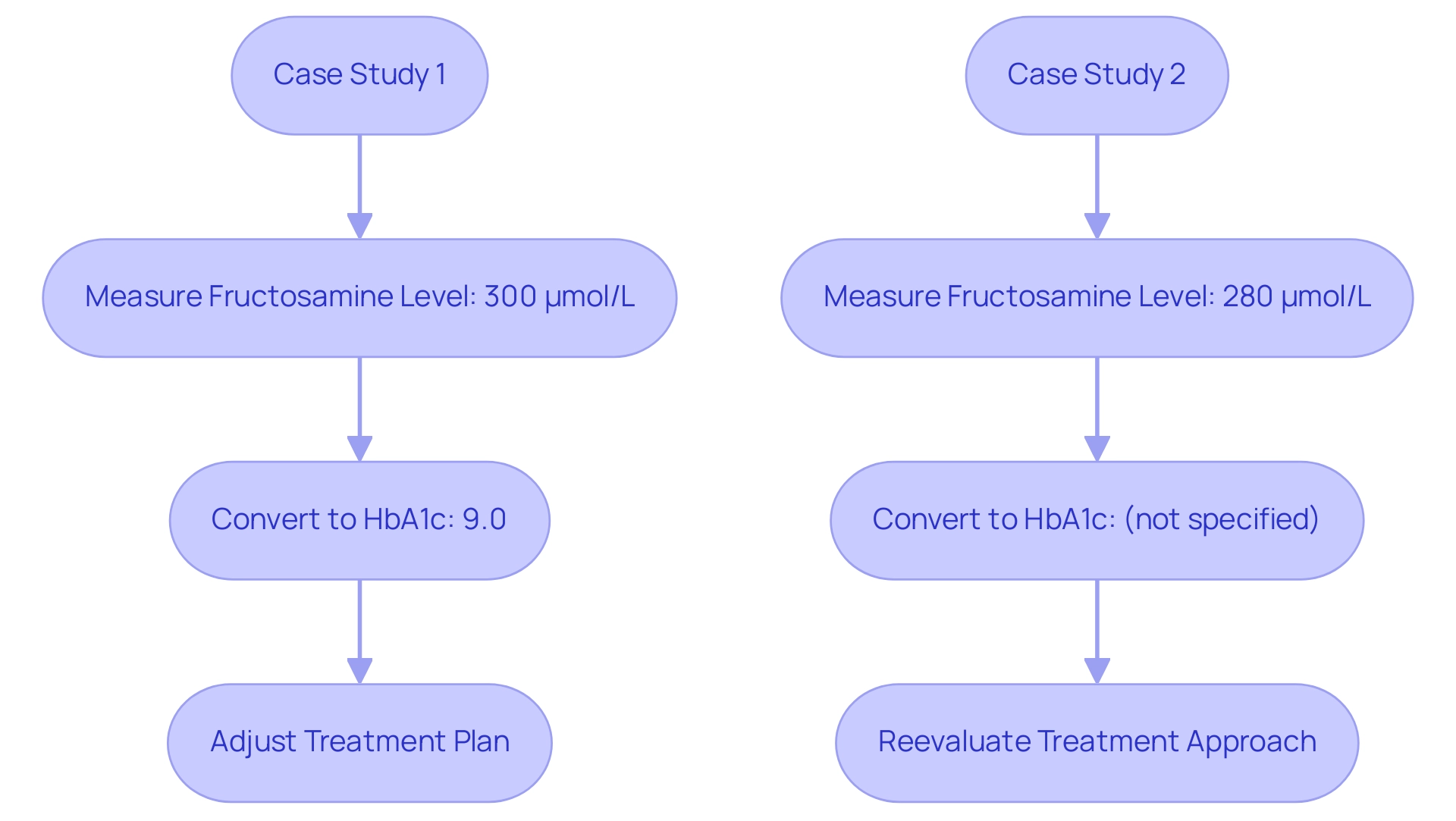
Conclusion
Fructosamine and HbA1c are vital markers in the management of diabetes, each offering unique insights into blood glucose levels. Fructosamine provides a short-term view of glycemic control over the past 2-3 weeks, making it essential for patients requiring immediate adjustments in their treatment. In contrast, HbA1c reflects average glucose levels over a longer period of 2-3 months, serving as the standard measure for assessing overall diabetes management. Understanding the differences and applications of these biomarkers is crucial for tailoring individualized treatment plans and improving patient outcomes.
The systematic approach to converting fructosamine to HbA1c enhances the ability of healthcare providers to assess glycemic control effectively. The step-by-step method outlined ensures accurate interpretation of results, particularly in complex clinical scenarios where traditional measures may fall short. Case studies further illustrate the practical implications of utilizing both markers, highlighting how timely insights can lead to informed treatment modifications and ultimately better management of diabetes.
Incorporating both fructosamine and HbA1c into routine diabetes care not only aids in monitoring but also supports the development of personalized treatment strategies. As the landscape of diabetes management evolves, leveraging these biomarkers can significantly enhance patient care and lead to improved health outcomes. The integration of comprehensive resources, such as those provided by T2DSolutions, empowers patients and healthcare providers alike to navigate the complexities of diabetes management effectively.



